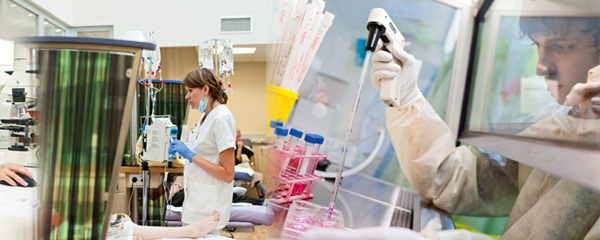Biochemistry is the science that studies the structure and chemical reactions of molecules within or produced by living materials. In particular, it provides better understanding of how organisms function. Biochemistry focuses on the structure, processes, cellular transformations and communication between cells, thus it is a logical ally in cancer research.
You are here
Glossary
Biochemistry
Bioinformatics
Bioinformatics is a field of research that analyses and interprets biological data by using computer science in order to create new knowledge in biology.
This is the definition given by Isabelle Quinkal and François Rechenmann.
Very briefly, two aspects of bioinformatics can be distinguished (2 types of skill):
- Data analysis: the application of algorithms and statistical models to interpret, classify and understand biological data;
- Computational biology: the development of mathematical models and tools to solve biological problems.
Bone marrow
Bone marrow is a fatty semi-liquid substance located in bones, especially in the vertebra (though very different from the spinal cord), the shoulder blades and the pelvis in adults.
Red bone marrow produces stem blood cells which, when mature, become blood cells. Thus it renews the red blood cells (ethrocytes), which carry oxygen, the white blood cells (leucocytes), which participate in the immune system, and platelets which participate in coagulation. It can be the site of a malignant transformation in the leucocytes and lead to leukaemia.
Bone marrow donation
Bone marrow transplants are the only solution for certain cancers such as leukaemia and lymphomas. The donor can be a member of the family or an unrelated or anonymous person, but who has been identified as being genetically compatible through donor registries. The marrow is harvested from the donor, generally from the pelvis, under general anaesthesia. Prior to the transplant, the recipient receives a treatment that destroys the malignant marrow cells and neutralises their immune system to avoid rejection. They are therefore hospitalised under specific conditions in a microbe-free environment. The patient receives the marrow stem cells prepared by intravenous injection and must remain in hospital until the transplant is accepted and their immunity reconstituted.

